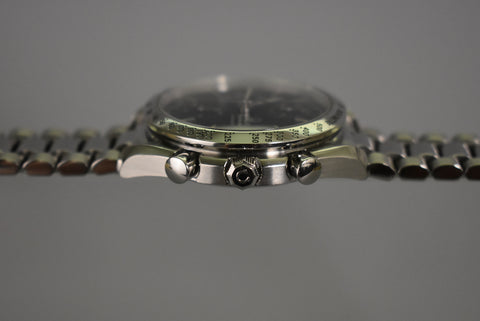J. Heffner | IG @pinaplwtchs |
A value prop of the Speedmaster market
The Omega Speedmaster is hardly referenced as an example of value in the watch community. This is partially attributed to its ‘icon’ status, and Omega’s pricing structure. Most consumers know exactly what makes the Speedmaster famous, and similarly to the Submariner or Tank Louis, an appropriate price tag is associated with such a watch.
However, there are in fact a few exceptions to this generalization. Many vintage/neo-vintage references of the iconic Speedy hide in the shadow of the more popular Moonwatch. These ‘lesser-known’ Speedmasters, while loved by true enthusiasts, are yet to garner the popularity they deserve by the wider watch community. That phenomenon, however, is on the verge of dramatically changing as this hobby continues to grow in reach and influence.
Take the MK II for example - still considered a professional reference with the popular 861 caliber inside, yet they still lurk well below the $3,000 mark. In a similar fashion, the 3511 reference line is no different.
Today’s discussion is one of hidden value and potential within the Speedmaster market, and a case study as to why the 3511 reference should at least be on your radar, let alone in your watch box.
History
The ‘3511’ reference refers to an umbrella of Speedmasters differentiated primarily by dial color. There are typically two proceeding numbers in the reference which designates variation (for example, the 3511.80 corresponding to a blue dial).

The inception of the 3511 is attributed to Omega’s efforts in the 1980s towards making more ‘accessible’ Speedmasters - that is, Speedmasters appealing to lovers of the design who likely won’t be going to space anytime soon.
One of the ways that Omega accomplished this feat was through their choice of movement. Instead of opting for the traditional hand-wound calibers (such as the 861), they chose automatic movements. This calculated decision provides a sense of ease for the wearer where forgetting to wind your watch is no longer an inconvenience.
The movement choice in the 3511 reference is also the primary differentiator from the 3510 (a.k.a. the Speedmaster Reduced). While the Speedmaster Reduced is more widely known amongst the watch community for its striking resemblance to the traditional Moonwatch, the movement inside is regarded as problematic by some.
Inside the reduced is an Omega caliber 3220 which is composed of an ETA 2892 with a separate chronograph module attached. The 3511 line, however, contains the Omega caliber 1155 which is based on the more reliable Valjoux 7750. In the watch community, there isn’t even a debate as to which movement is preferred.

Design
Similarly to the reduced, the 3511 line contrasts the traditional 42mm sizing of a Speedmaster with a 39mm case diameter. They do, however, feature the same twisted lugs and overall case design as the original Speedmasters from decades prior.
The dial is where the 3511 line truly distinguishes itself from any other Speedmaster out there. Hailing from the early 2000s, the dials are overtly playful and offer real contrast to Omega’s typically conservative designs.
Aside from the movement inside, the dials are what truly characterize the popularity of these models amongst true collectors.
In a similar fashion, the both the bezel and chrono layout are a play on the Speedmaster’s design, and are indicative of the era in which they were produced. A beautifully polished tachymeter scale and mischievous subdial layout seemingly complete the vibe of this unique, yet lovable Speedy.

Collectability
Often when I discuss collectability and value, I draw reference to similar pieces within the same price range essentially demonstrating the competition a particular piece is up against. With the 3511 however, it’s difficult provided that not much else can categorically ‘beat’ this piece and offer more bang-per-buck.
In all corners of the world, the Speedmaster is known not only for its design but impressive accomplishments. With the 3511, you can own a piece of that heritage for nearly half the price of an old Oyster Perpetual.
While the design elements are a more playful ploy of an icon, they retain the same functionalities and perks of a truly original Omega - from a tachymeter scale to a hippocampus caseback.

Ultimately, I foresee these criminally underrated pieces increasing steadily in popularity, especially as we see the rise of neo-vintage and more conservatively sized watches. Whether this piece speaks to you or not, I wouldn’t wait to hunt down a nice example as they lean further into rarity.


Leave a comment